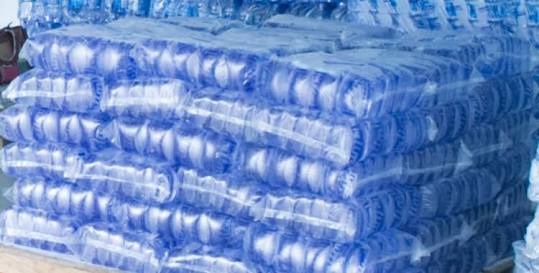
'Pure water' prices to increase October 31, second time in two months
The National Association of Sachet and Packaged Water Producers (NASPAWAP) has recommended that one iced sachet water (pure water) should be retailed at 60 pesewas effective Monday, October 31, 2022.
It also recommended that one iced bottled water - 500ml be retailed at GH¢2.50, one iced bottled water - 750ml or medium size be retailed at GH¢3.50 and one iced bottle water - 1.5litre be retailed at GH¢5.00.
Advertisement
Surging pure water prices
It is the second time in consecutive months that the retail price of sachet water has been increased by NASPWAP.
The last increment on Monday, September 19, 2022, saw a sachet of water popularly called (pure water) being sold at 50 pesewas, with a 500 millilitre (ml) bottle of water at GH¢2, while the 750 ml and the 1.5 litre bottles increased to GH¢ 2.5 and GH¢3.50, respectively.
Additionally, a bag of sachet water - 30 sachets (500ml), which was being sold by retail trucks at GH¢7 a month ago will now be sold at GH¢10 while the retail price at mini shops which was GH¢9 will increase to between GH¢12 and GH¢15 depending on the location of the shop.
Related Articles
'Pure water' prices to increase October 31, second time in two months
Cost of sachet water, transport fares to go up
Sachet water sells at 50p, bag retails at GH₵7, GH₵9 from Sept 19
Sachet water to sell at GH¢0.40p effective April 1
Sachet water main source of drinking water in Ghana - Census Report
Last week, the NASPAWAP threatened to halt production in the country as a result of the depreciation of the cedi, increment of fuel prices, and inflation.
In a press release issued today, the water producers said the latest increment had been necessitated by the rising cost of inputs such as fuel and packaging materials which had affected the working capital of its members.
The release added that on October 24, 2022, a ton of sachet film used for packaging water was increased from GH¢25,000.00 to GH¢36,000.00, representing a 44% rise.
"Shortly after our press statement(last week), the Ghana Plastic Manufacturers Association (GPMA) released new prices of plastic films and preforms used in sachet and bottled water packaging," the release said.
"Diesel fuel price is about GHc20.00 per litre at the pumps as of Wednesday 26th October. This means producers' working capital had dwindled by about 45% within 7 days since the NEC issued the distress call to government. As a result, most packaged water producers are currently unable to purchase materials to the expected levels while other are not operating as they cannot afford the losses of 45% on their working capital.
"Giving the urgency of the situation, an emergency stakeholder engagement was called on the 26th October 2022, to review the effect of the continuous increases of fuel slf films preforms and vehicle spare parts, taking into consideration the need to maintain the production of quality packaged water to the citizens".
Main source of water - GSS
Sachet water is the main source of drinking water in Ghana.
According to the 2021 Ghana Population and Housing Census - General Report Volume 3M; Water and Sanitation, 37.4% of households use sachet water as their main source of drinking water followed by pipe-borne water which was used by 31.7% of households and borehole/tube which was used by 17.7% of households.
The census data also found that in urban areas the two main sources of drinking water was sachet water which was used by 51.5% of households and pipe-borne water which was used by 33.6% of households while in rural areas, borehole/tube well was used by 33.6% of households and pipe-borne water was used by 28.8% of households.
However, the report also found that the use of sachet water as the main source of drinking water was largely an urban phenomenon (51.5%). It is the most used source of drinking water in Greater Accra (70.7%) and the least in North East (1.8%), Upper East (2.2%) and Upper West (2.6%) regions.
"Sachet water a personal choice"
Reacting to the findings which were released by the Ghana Statistical Service last February, the Minister for Sanitation and Water Resources, Mrs Cecilia Abena Dapaah said drinking sachet and bottled water was a personal decision taken by most Ghanaians.
She added that pipe-borne water produced by the Ghana Water Company Limited (GWCL) was one of the best sources of drinking water with pH levels higher than the World Health Organization standard which lies within the range 6.5–8.5
She also stated that 90% of sachet and bottled water was packaged from water produced by the GWCL.
"I pointed out at a meeting that we don't have any sachet water business in Nigeria, we can find out but it is true. I have driven through villages and hamlets (in Nigeria), they don't have it," Mrs Dapaah said.
"It is a decision taken by the individual to use sachet water because I will put it on record that Ghana Water produces one of the best sources of drinking water even the pH levels are at times higher than the WHO standards.
"So, our source is very good but we have all come into this socio-cultural thing of bottled water and sachet water. Nigeria with its population has no sachet water, so this idea of sachet water dominating drinking water is a choice. I am not saying people should be forced as a policy to use tap water, it's a decision by the individuals and more so 90 per cent of the water used for this packaging is from Ghana Water Company Limited even for the bottling, a few of them use springs and wells et cetera but we as a nation through Ghana Water, we produce one of the best sources".